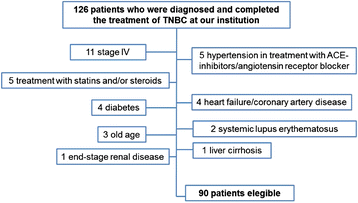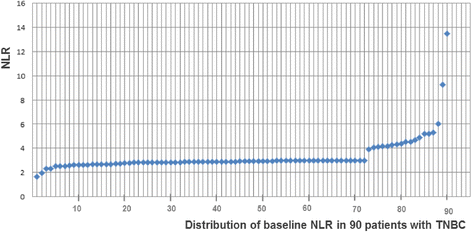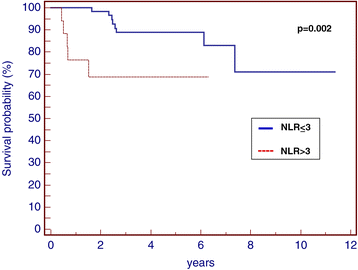Pre-treatment neutrophil to lymphocyte ratio may be a useful tool in predicting survival in early triple negative breast cancer patients
- PMID: 25884918
- PMCID: PMC4428113
- DOI: 10.1186/s12885-015-1204-2
Pre-treatment neutrophil to lymphocyte ratio may be a useful tool in predicting survival in early triple negative breast cancer patients
Abstract
Background: There is a growing body of evidence that immune response plays a large role in cancer outcome. The neutrophil to lymphocyte ratio (NLR) has been used as a simple parameter of systemic inflammation in several tumors. The purpose was to investigate the association between pre-treatment NLR, disease-free survival and overall survival in patients with early triple negative breast cancer (TNBC).
Methods: We reviewed the records of patients with stage I-III TNBC at our Institution from 2006 to 2012. The association between pre-treatment NLR and survival was analyzed. The difference among variables was calculated by chi-square test. DFS and OS were estimated using Kaplan-Meier method. Cox analysis was performed to analyze clinical parameters for their prognostic relevance.
Results: A total of 90 patients were eligible. There was no significant correlation among pre-treatment NLR and various clinical pathological factors. Patients with NLR higher than 3 showed significantly lower DFS (p = 0.002) and OS (p = 0.009) than patients with NLR equal or lower than 3. The Cox proportional multivariate hazard model revealed that higher pre-treatment NLR was independently correlated with poor DFS and OS, with hazard ratio 5.15 (95% confidence interval [CI] 1.11-23.88, p = 0.03) and 6.16 (95% CI 1.54-24.66, p = 0.01) respectively.
Conclusion: Our study suggests that pre-treatment NLR may be associated with DFS and OS patients with early TNBC. Further validation and a feasibility study are required before it can be considered for clinical use.
Figures






References
-
- Dent R, Trudeau M, Pritcherd KI, Hanna WM, Kahn HK, Sawka CA, et al. Triple negative breast cancer: Clinical features and patterns of recurrence. Clin Cancer Res. 2013;1(13):4429–34. - PubMed
-
- Pistelli M, Pagliacci A, Battelli N, Santinelli A, Biscotti T, Ballatore Z, et al. Prognostic factors in early-stage triple-negative breast cancer: lesson and limits from clinical practice. Anticancer Res. 2013;33(6):2737–42. - PubMed
MeSH terms
LinkOut - more resources
Full Text Sources
Other Literature Sources
Medical

